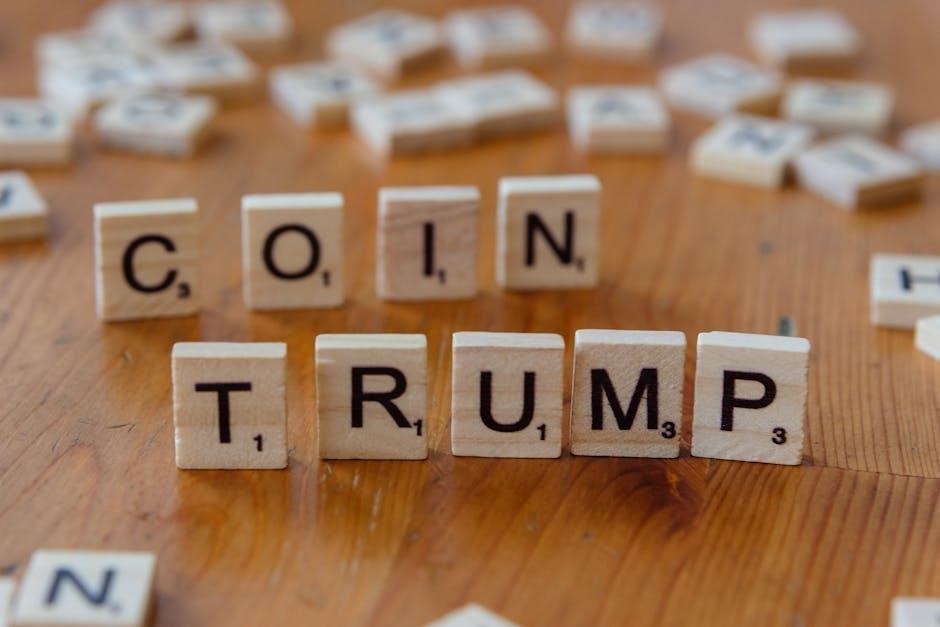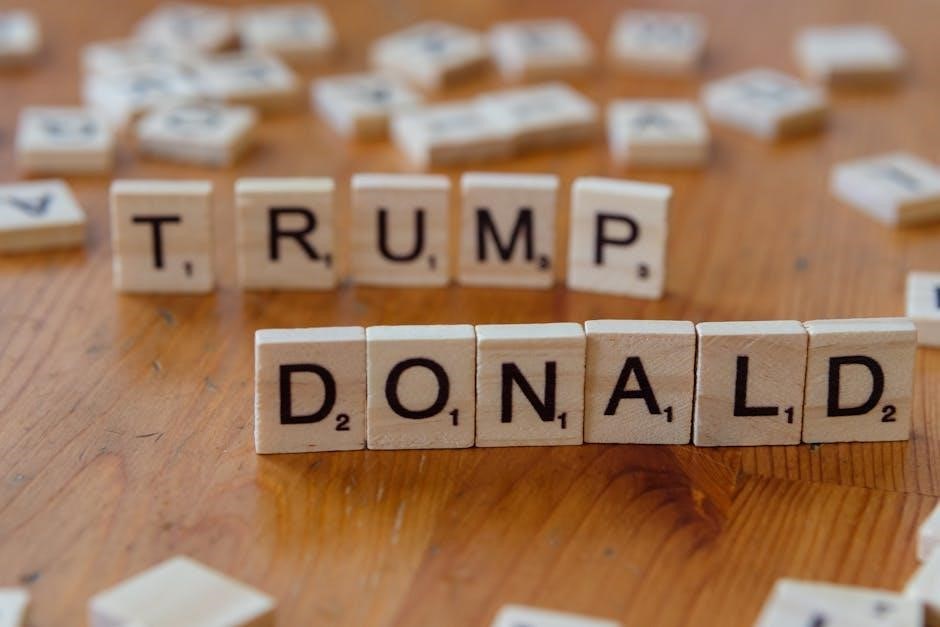
nghệ thuật đàm phán donald trump pdf
Donald Trump’s negotiation art, as outlined in his book “The Art of the Deal”, provides insights into his strategies for success․ Available as a free PDF, it remains a key resource for understanding his approach to business and life․
1․1․ Overview of “The Art of the Deal” Book
“The Art of the Deal” by Donald Trump, available as a free PDF, is a guide to negotiation and success․ It outlines Trump’s strategies for deal-making, emphasizing persistence, creativity, and confidence․ The book highlights key principles like thinking big and maintaining focus, illustrated through real-world examples such as the Tiffany & Co․ deal․ It also explores the importance of understanding human psychology and emotional intelligence in negotiations․ Trump shares practical advice on creating win-win situations and knowing when to walk away․ The book is both a business manual and a personal philosophy, offering insights into Trump’s approach to life and commerce, making it a valuable resource for aspiring entrepreneurs and professionals alike․
1;2․ Importance of Negotiation in Business and Life
Negotiation is a cornerstone of business and personal success, as highlighted in “The Art of the Deal”․ It enables individuals to secure favorable outcomes, build relationships, and resolve conflicts․ Trump’s approach underscores the value of negotiation in achieving goals, whether in real estate, partnerships, or everyday interactions․ Effective negotiation fosters collaboration, enhances reputation, and drives growth․ It also empowers individuals to navigate challenges confidently, ensuring mutually beneficial solutions․ By mastering negotiation, one can unlock opportunities, strengthen connections, and achieve lasting success in both professional and personal realms, as demonstrated by Trump’s career and teachings in his widely accessed free PDF guide․
1․3․ Trump’s Philosophy on Winning Deals
Donald Trump’s philosophy on winning deals revolves around confidence, persistence, and thinking big․ In “The Art of the Deal”, he emphasizes the importance of total focus and a “controlled neurosis” to achieve success․ Trump advocates for calculated risks, knowing when to walk away, and leveraging negotiation to maximize outcomes․ His approach is rooted in understanding the other party’s needs while maintaining a strong stance․ By combining creativity, determination, and a relentless drive to succeed, Trump’s philosophy ensures that deals are not just transactions but strategic victories that align with his vision and goals․

Key Principles of Trump’s Negotiation Style
Trump’s negotiation style emphasizes confidence, persistence, and thinking big․ He stresses knowing when to walk away, maximizing outcomes, and maintaining a relentless drive to succeed in deals․
2․1․ Thinking Big: The Foundation of Success
Thinking big is central to Trump’s negotiation philosophy, as detailed in his “The Art of the Deal” PDF․ He believes setting ambitious goals attracts opportunities and fosters success․ By maintaining a large vision, individuals can approach negotiations with confidence and resilience, ultimately achieving better outcomes․ This mindset helps negotiators stay focused and motivated, even in challenging situations․ Trump emphasizes that thinking big is not just about aiming high but also about maintaining a mental discipline that drives creativity and innovation in deal-making․
2․2․ Knowing When to Walk Away
Knowing when to walk away is a crucial aspect of Trump’s negotiation strategy, as highlighted in “The Art of the Deal” PDF․ Trump emphasizes that walking away demonstrates strength and prevents settling for subpar deals․ It signals confidence and forces the other party to reconsider their position․ This tactic is not about surrender but about strategic maneuvering․ For instance, Trump recounts how he walked away from a deal with Tiffany & Co․ until terms favored him․ This approach underscores the importance of patience and self-control in high-stakes negotiations, ensuring that one only commits to advantageous agreements․
2․3․ The Power of Confidence in Negotiations
Confidence is a cornerstone of Trump’s negotiation style, as detailed in his “The Art of the Deal” PDF․ Trump believes that unwavering self-assurance can shift the balance of power in any negotiation․ He advises projecting certainty and authority, even when uncertain․ This mindset intimidates opponents and creates an aura of control․ Trump illustrates this with his deals, where his confidence often led opponents to concede․ However, he warns against arrogance, emphasizing that confidence must be balanced with realism․ By maintaining a strong, assured demeanor, negotiators can secure favorable outcomes and build lasting business relationships․

Strategies for Effective Negotiation
Effective negotiation requires preparation, creativity, and assertiveness․ Trump emphasizes knowing your opponent’s needs and leveraging time to your advantage․ Confidence and strategic thinking are key․
3․1․ Creating a Win-Win Situation
Creating a win-win situation is a cornerstone of Trump’s negotiation philosophy․ By understanding both parties’ needs, he ensures mutual success․ This approach builds trust and fosters long-term partnerships, as seen in his business deals․ In “The Art of the Deal”, Trump highlights how focusing on shared goals leads to sustainable agreements․ He advises negotiators to seek solutions where both sides feel valued, enhancing relationships and future collaborations․ This strategy not only secures favorable terms but also maintains a positive reputation, crucial for ongoing success in business and personal endeavors․
3․2․ Using Time to Your Advantage
Donald Trump emphasizes the strategic use of time in negotiations․ Patience and timing are critical tools, allowing negotiators to assess situations and act decisively․ In “The Art of the Deal”, Trump illustrates how delaying decisions can create leverage, providing opportunities to reassess terms or withdraw if necessary․ Time pressure can be manipulated to influence outcomes, ensuring advantageous deals․ By mastering the art of timing, negotiators can achieve desired results while maintaining control over the process․ This approach underscores Trump’s belief in calculated risk-taking and the importance of patience in securing favorable outcomes․
3․3․ Mastering the Art of Persuasion
Donald Trump’s negotiation strategies highlight the importance of persuasion as a cornerstone of successful deal-making; In “The Art of the Deal”, he emphasizes the need to understand the other party’s motivations and desires․ By framing offers in a way that aligns with their interests, Trump argues that negotiators can build rapport and influence decisions․ Effective persuasion involves confidence, clarity, and the ability to tell compelling stories․ Trump’s techniques, such as anchoring and concessions, are designed to create a psychological edge, making it easier to guide the conversation toward a favorable outcome․ This approach ensures that negotiations remain dynamic and advantageous․

Psychological Aspects of Negotiation
Understanding human psychology is crucial in negotiation, as highlighted in Trump’s strategies․ Emotional intelligence and controlling emotions are key to achieving better outcomes in deals and interactions․
4․1․ Understanding Human Psychology in Deals
Understanding human psychology is vital in negotiations, as emphasized in Trump’s strategies․ By reading people’s motivations and emotions, one can tailor approaches to align with their interests․ Empathy and strategic positioning are key tools, allowing negotiators to frame offers favorably․ For instance, in the Tiffany & Co․ deal, Trump leveraged psychological insights to secure advantageous terms․ His ability to understand and manipulate perceptions created a win-win scenario, showcasing the power of psychological acumen in deal-making․ This approach, detailed in “The Art of the Deal” PDF, highlights how mastering human behavior can lead to successful outcomes in business and personal interactions․
4․2․ Emotional Intelligence in Negotiation
Emotional intelligence plays a crucial role in Trump’s negotiation tactics, as highlighted in his book․ Self-awareness, empathy, and social skills are essential for managing emotions during deals․ Trump’s ability to remain composed under pressure and read others’ emotional states allows him to navigate complex negotiations effectively․ By controlling his own emotions, he maintains the upper hand, preventing emotional decisions from clouding judgment․ This approach, detailed in “The Art of the Deal” PDF, underscores how emotional intelligence can transform negotiations into strategic, calculated interactions, fostering trust and cooperation while achieving desired outcomes․
4․3․ Controlling Emotions for Better Outcomes
Trump emphasizes the importance of emotional control in negotiations, as detailed in his “The Art of the Deal” PDF․ Maintaining composure under pressure is vital to avoid impulsive decisions․ By staying calm and focused, negotiators can think strategically, capitalizing on opportunities while minimizing risks․ Trump’s approach highlights how emotional discipline prevents personal biases from interfering, ensuring rational decision-making․ This tactic, as outlined in his book, fosters an environment of clarity and confidence, leading to more favorable outcomes in business and personal dealings․ Emotional mastery, as Trump illustrates, is a cornerstone of successful negotiation strategies․

Real-World Examples of Trump’s Negotiations
Trump’s negotiations, detailed in his “The Art of the Deal” PDF, include high-profile deals like the Tiffany & Co․ air rights and casino ventures, showcasing his strategic prowess․
5․1․ The Tiffany & Co․ Deal: A Case Study
Donald Trump’s negotiation with Tiffany & Co․ exemplifies his strategic brilliance․ The deal involved acquiring air rights above the company’s Fifth Avenue location, a crucial step in building Trump Tower․ Trump’s approach was both assertive and respectful, ensuring a win-win scenario․ He focused on maintaining a positive relationship, which was vital for the deal’s success․ The partnership concluded amicably, with Trump describing it as a “class act from the start․” This case study highlights Trump’s ability to balance assertiveness with diplomacy, demonstrating how his negotiation tactics can lead to mutually beneficial outcomes․ It remains a prime example of his deal-making prowess․
5․2․ Negotiating with Casinos and Real Estate
Donald Trump’s negotiations in the casino and real estate industries showcase his mastery of high-stakes deals․ In Atlantic City, Trump strategically negotiated casino licenses and financing, leveraging his reputation to secure favorable terms․ His ability to think big and negotiate aggressively was key to acquiring prime properties․ Trump’s confidence and persuasive skills allowed him to navigate complex financial arrangements, often turning potentially risky ventures into profitable successes․ These deals highlight his tenacity and skill in transforming challenges into opportunities, solidifying his reputation as a formidable negotiator in both industries․ His strategies continue to serve as valuable lessons in modern business negotiations․
5․3․ Lessons from Trump’s Business Failures
Despite his successes, Donald Trump’s career has also seen significant failures, offering valuable lessons․ The bankruptcies of his Atlantic City casinos and the demise of the Trump Shuttle highlight the importance of risk management․ These failures taught Trump the need for due diligence and adaptability․ He learned to negotiate exits strategically, minimizing losses while preserving his brand․ Trump’s resilience in bouncing back underscores his ability to turn setbacks into opportunities․ These experiences shaped his negotiation philosophy, emphasizing the importance of contingency planning and knowing when to walk away․ His failures serve as a reminder that even in defeat, there is room for growth and strategic recalibration․

Negotiation Tactics for Everyday Life
Trump’s negotiation tactics can be applied to everyday life, from personal relationships to salary negotiations․ His strategies emphasize confidence, active listening, and knowing when to compromise or walk away․
- Personal relationships: Use empathy and clear communication to build trust and mutual understanding․
- Salary negotiations: Research market value and confidently articulate your worth to employers;
- Daily transactions: Stay patient, know your limits, and be ready to negotiate terms that benefit both parties․
6․1․ Applying Trump’s Tactics in Personal Relationships
Trump’s negotiation tactics can enhance personal relationships by fostering mutual respect and understanding․ His emphasis on confidence and emotional intelligence helps navigate conflicts effectively․ By maintaining control over emotions and focusing on solutions, relationships become more harmonious․ Active listening and clear communication, as highlighted in “The Art of the Deal”, build trust and strengthen bonds․ Setting boundaries and knowing when to compromise or walk away ensures healthy dynamics․ These strategies promote win-win outcomes, turning personal interactions into opportunities for growth and connection, aligning with Trump’s philosophy of creating value in every relationship․ Adapt these tactics to cultivate stronger, more meaningful personal connections․
6․2․ Negotiating Salary and Job Offers
Trump’s negotiation tactics can be effectively applied when negotiating salary and job offers․ Confidence and assertiveness are key, as emphasized in “The Art of the Deal”․ Researching market value ensures a strong foundation for your demands․ Start with a high anchor point to create room for negotiation․ Highlight your unique skills and contributions to justify your request․ Be prepared to walk away if the offer doesn’t meet your expectations, demonstrating your willingness to stand by your worth․ Focus on creating a win-win situation, where both parties feel satisfied․ These strategies can help you secure better terms and set a positive tone for your professional relationship․
6․3․ Using Negotiation Skills in Everyday Transactions
Trump’s negotiation principles extend beyond business, applicable to everyday transactions․ Whether buying a car, negotiating rent, or haggling at a market, confidence and creativity are essential․ Start with a strong opening offer, using silence to your advantage․ Be prepared to walk away if terms aren’t favorable․ Focus on mutual benefit, ensuring both parties feel satisfied․ These tactics, outlined in “The Art of the Deal”, can save money and build stronger relationships․ By staying firm yet polite, you can turn everyday interactions into opportunities for favorable outcomes, demonstrating the versatility of Trump’s negotiation art in all aspects of life․

The Role of Risk-Taking in Negotiation
Trump emphasizes calculated risk-taking in negotiations, advocating for bold moves while assessing potential outcomes․ This approach, detailed in his PDF, balances daring strategies with informed decisions to achieve success․
7․1․ Calculated Risks: When to Take Them
Donald Trump’s philosophy, as outlined in his “The Art of the Deal” PDF, highlights the importance of taking calculated risks․ He suggests assessing potential outcomes thoroughly before making bold moves․ This strategy involves weighing the pros and cons, understanding the market, and having a clear exit plan․ Trump advises taking risks when the reward outweighs the potential loss, emphasizing confidence and preparation․ His approach encourages entrepreneurs to embrace uncertainty but with a well-thought-out strategy․ By balancing audacity with prudence, Trump demonstrates how calculated risks can lead to significant successes in business and negotiations, as detailed in his free PDF guide․
7․2․ Managing Risk in High-Stakes Deals
Managing risk in high-stakes deals is a cornerstone of Donald Trump’s negotiation strategy, as detailed in his “The Art of the Deal” PDF․ Trump emphasizes the importance of meticulous preparation, thorough research, and understanding the motivations of all parties involved․ He advises negotiators to identify potential pitfalls early and develop contingency plans․ By controlling variables and maintaining flexibility, one can mitigate risks while maximizing opportunities․ Trump’s approach also stresses the value of confidence and resilience in navigating complex deals․ His strategies, outlined in the free PDF, provide practical insights for turning high-risk scenarios into profitable outcomes through disciplined risk management․
7․3․ Learning from Failed Risks
Donald Trump’s negotiation philosophy, as outlined in his “The Art of the Deal” PDF, highlights the importance of learning from failed risks․ Trump believes that setbacks are inevitable but can serve as valuable lessons․ He emphasizes analyzing what went wrong, identifying missteps, and adjusting strategies accordingly․ Trump’s approach encourages resilience, viewing failures as stepping stones to success․ By understanding the root causes of failed risks, negotiators can refine their tactics and improve future outcomes․ This mindset, detailed in his free PDF, underscores the importance of adaptability and continuous improvement in high-stakes negotiations, turning failures into opportunities for growth․

The Art of Deal-Making in the Digital Age
Donald Trump’s negotiation tactics, detailed in his “The Art of the Deal” PDF, emphasize adapting strategies to modern business․ Digital tools and technology now enhance deal-making, enabling faster communication and data-driven decisions, aligning with Trump’s competitive approach to negotiations․
8․1․ Adapting Trump’s Strategies to Modern Business
Adapting Donald Trump’s negotiation strategies to modern business involves leveraging digital tools and technology to enhance deal-making; Trump’s principles, such as thinking big and maintaining confidence, remain relevant but must be integrated with contemporary practices․ The rise of virtual meetings, data analytics, and AI-driven insights allows for more informed decision-making․ By blending traditional negotiation tactics with modern innovations, businesses can streamline processes and achieve outcomes aligned with Trump’s competitive approach․ This fusion ensures that Trump’s timeless strategies evolve alongside technological advancements, making them applicable to today’s fast-paced business environment while maintaining their core effectiveness․
8․2․ The Role of Technology in Negotiations
Technology plays a pivotal role in modern negotiations, transforming how deals are struck and managed․ Digital platforms facilitate real-time communication, enabling faster decision-making and global collaboration․ Tools like video conferencing, AI-driven analytics, and secure document sharing enhance efficiency and transparency․ Data analytics provides insights into market trends and counterpart preferences, empowering negotiators with actionable intelligence․ Additionally, blockchain technology ensures secure and tamper-proof agreements, building trust․ While Trump’s negotiation art emphasizes personal interaction, integrating technology optimizes these traditional methods, ensuring they remain effective in today’s digital-first business landscape․ This synergy between classic strategies and modern tech drives successful outcomes in contemporary deal-making environments․
8․3․ Digital Tools for Effective Deal-Making
Digital tools have revolutionized deal-making, offering innovative solutions to streamline negotiations․ Platforms like Zoom and Microsoft Teams enable virtual meetings, while tools like Trello and Asana facilitate collaborative project management․ E-signature platforms such as DocuSign accelerate agreement finalization, reducing paperwork․ Contract management software ensures transparency and compliance, while CRM systems like Salesforce track relationships and data․ Analytics tools provide insights into negotiation patterns, optimizing strategies․ Access to resources like “The Art of the Deal” PDFs online has democratized knowledge sharing, empowering negotiators globally․ These tools enhance efficiency, ensuring deals are struck faster and with greater precision, aligning with Trump’s emphasis on speed and success in modern negotiations;

Ethical Considerations in Negotiation
Ethical negotiation involves fairness, transparency, and integrity․ Avoiding deceit and manipulation is crucial for maintaining trust and long-term relationships, as emphasized in Trump’s “Art of the Deal” principles․
9․1․ Ethical vs․ Unethical Negotiation Tactics
Negotiation ethics play a critical role in maintaining trust and credibility․ Ethical tactics involve transparency, honesty, and fairness, fostering long-term relationships․ In contrast, unethical tactics, such as manipulation or deception, can damage reputations and lead to legal consequences․ Trump’s “The Art of the Deal” highlights the importance of integrity, emphasizing that ethical practices build respect and sustainable success․ However, critics argue that some of Trump’s strategies blur the line between assertiveness and exploitation․ Balancing assertiveness with ethics is key to achieving outcomes that benefit all parties without compromising moral standards․
9․2․ Maintaining Integrity in Business Deals
Maintaining integrity in business deals is crucial for building trust and long-term success․ Trump’s “The Art of the Deal” emphasizes the importance of honesty and fairness․ Ethical practices ensure that all parties feel respected and valued․ By adhering to moral standards, businesses can avoid legal and reputational risks․ Transparency in negotiations fosters credibility and strengthens relationships․ Trump’s philosophy highlights that true success comes from deals where integrity is never compromised, ensuring sustainable growth and mutual benefit․ This approach not only enhances personal and professional reputation but also contributes to a positive business environment․
9․3․ The Consequences of Unethical Negotiation
Engaging in unethical negotiation can lead to severe consequences, including legal repercussions and damaged reputations․ Trump’s “The Art of the Deal” highlights the importance of integrity, warning that unethical tactics can erode trust and harm long-term relationships․ Unscrupulous practices may yield short-term gains but often result in financial losses and loss of credibility․ Additionally, unethical behavior can foster a toxic business environment, discouraging future partnerships․ The fallout from such actions can be irreversible, undermining personal and professional legitimacy․ Therefore, upholding ethical standards is essential for fostering trust and ensuring sustainable success in business and personal dealings․

The Future of Negotiation and Deal-Making
Trump’s negotiation principles remain timeless, integrating with modern tools like AI and digital platforms to enhance deal-making efficiency and adapt to evolving business landscapes․
10․1․ Emerging Trends in Negotiation Styles
Emerging trends in negotiation styles emphasize adaptability, blending traditional tactics with modern tools․ Trump’s principles, as detailed in “The Art of the Deal”, are evolving alongside digital advancements․ The integration of AI and data analytics now complements interpersonal skills, enabling more precise deal-making․ Emotional intelligence and psychological insights remain central, but negotiators are increasingly leveraging technology to predict outcomes and optimize strategies․ Collaboration and sustainability are also gaining prominence, reflecting shifting societal values․ These trends suggest a future where negotiation is a dynamic blend of human intuition and technological precision, ensuring Trump’s legacy endures in a rapidly changing world․
10․2․ The Impact of AI on Negotiation
AI is revolutionizing negotiation by providing data-driven insights and predictive analytics․ Tools analyze counterpart behavior, offering strategies to achieve optimal outcomes․ Trump’s methods, outlined in “The Art of the Deal”, now integrate AI to enhance decision-making․ While AI streamlines processes, human skills like persuasion remain vital․ This blend of technology and intuition creates a powerful approach, ensuring adaptability in modern deals․ As AI advances, its role in negotiation will expand, making it an essential tool for effective deal-making in a competitive landscape․
10․3․ Evolution of Trump’s Negotiation Philosophy
Donald Trump’s negotiation philosophy has evolved significantly over time, adapting to changing business landscapes․ His foundational principles, as detailed in “The Art of the Deal”, emphasize confidence, strategic thinking, and knowing when to walk away․ These ideas, now available in various formats like free PDFs, have influenced modern deal-making․ Trump’s philosophy has incorporated new strategies, including leveraging technology and data analytics, to remain relevant in a competitive world․ This evolution reflects his ability to adapt while maintaining core principles, ensuring his negotiation tactics continue to inspire and inform business practices globally․
Donald Trump’s negotiation strategies, detailed in “The Art of the Deal”, offer timeless insights into achieving success․ His philosophy continues to inspire modern business practices and personal growth․
11․1․ Summarizing Trump’s Negotiation Strategies
Donald Trump’s negotiation strategies, as outlined in “The Art of the Deal”, emphasize thinking big, maintaining confidence, and understanding the opponent’s perspective․ He advocates for calculated risks, such as knowing when to walk away, to maximize outcomes․ Trump’s approach also highlights the importance of emotional control and creating win-win situations․ These principles, now widely discussed in PDF summaries and analyses, provide a roadmap for achieving success in both business and personal dealings, reflecting his belief in the power of focused determination and strategic adaptability․
11․2․ Practical Application of Trump’s Principles
Applying Trump’s principles involves integrating strategies like confidence, focus, and emotional control into daily negotiations․ As detailed in “The Art of the Deal” PDFs, individuals can adopt these tactics in various scenarios, from business deals to personal relationships․ For instance, understanding the importance of timing and knowing when to walk away can enhance bargaining power․ Additionally, fostering win-win situations ensures long-term relationships and mutual benefits․ By adapting these methods, individuals can navigate complex negotiations more effectively, aligning with Trump’s emphasis on success through strategic and calculated approaches, as widely discussed in available digital resources and analyses․
11․3․ The Lasting Legacy of “The Art of the Deal”
“The Art of the Deal” has left an indelible mark on negotiation strategies, offering timeless insights into business and personal success․ Available as a free PDF, the book has become a cornerstone for understanding Trump’s approach to deal-making․ Its emphasis on confidence, calculated risks, and emotional control continues to influence professionals and entrepreneurs globally․ The book’s practical advice, such as creating win-win situations and knowing when to walk away, remains highly relevant in modern business․ As highlighted in various analyses, its legacy endures as a guide for effective negotiation, ensuring its continued impact on future generations of leaders and deal-makers․